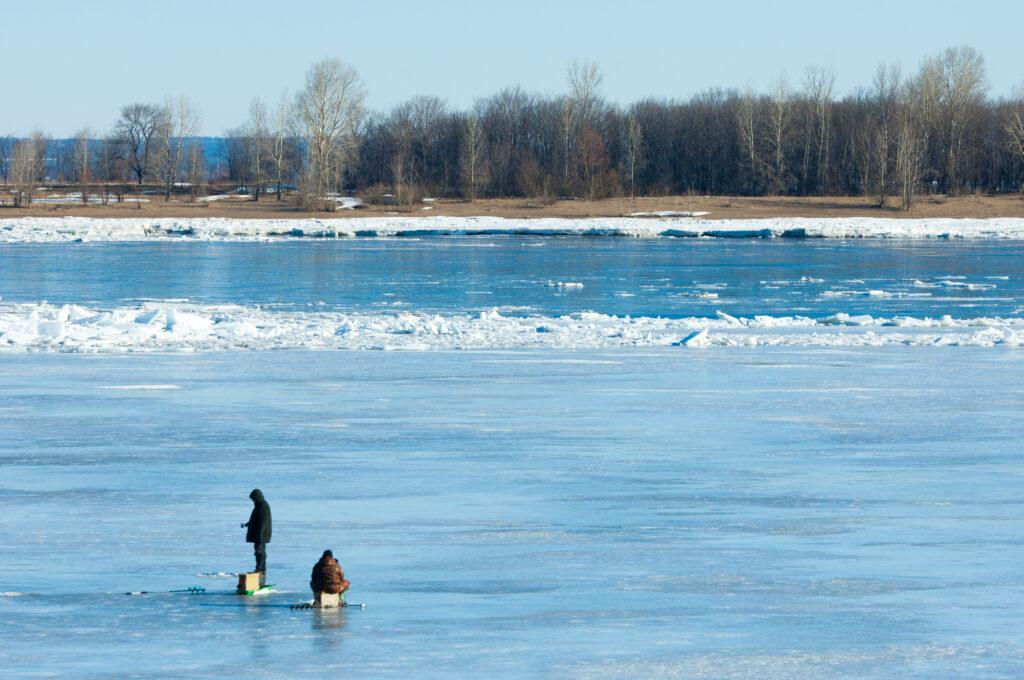Walleye are a popular catch for ice fishermen. They are dormant and passive in the winter but still feed. They are scavengers and will eat whatever comes in proximity to them. Learning their habits and finding them under the ice can help you land decent size walleye this winter.
The depth you should ice fish for walleye is between 30-50 feet (in mid-winter). As the waters warm, these depths decrease to shallower areas.
Walleye can be found at different depths throughout different times in winter. They will migrate to different areas to feed. In the early days of winter, they will feed in shallower parts of the lake. In the colder months, they will move to the edges of deeper areas of lakes. As it begins to warm up, it will once again migrate inward in preparation for spawning.
Below we will look at walleye’s habits to find walleye at different times of the winter or even different times of the day.

How Deep are Walleye Found in the Winter?
Walleye will be found at different depths throughout the winter. They can be found in shallow waters in the early and late portions of the winter. They will be closer to deeper waters in the coldest, middle days of winter.
Early Winter
During the early winter months of November and December, walleye will still feed on small fish such as perch in shallow waters near the shore. They will be in as little as 4 to 8 feet to feed on minnows and shiners here through the night.
Middle of Winter
In the middle winter months, walleye become more dormant and move further out in the lake when the weather and water temperatures become colder. They will be found at depths of 30 to 40 feet near drop-offs in the water during the day. This gives them easy access to shallower 10 to 25-foot waters they feed on during the nighttime.
They tend to stay just below the depth they usually find schools of perch and minnows.
Early Spring
Early in the spring, when the ice starts to break up, walleye will begin the process of spawning. They will move into shallower waters, usually near any warmer streams or rivers entering the lake. They will feed on bait fish found in these locations.
Walleye Movement Throughout Each Day
Walleye have sensitive eyes and will stay in deeper waters during the day. They avoid shallow waters during bright sunlight but will feed in shallower waters during the day when it is overcast or dimly lit. If a storm or darker clouds move in during daylight hours, you may see walleye migrate towards shallow waters to feed.
On bright, sunny days, walleye will stay in deeper waters. When the sun begins to set, they move to shallow waters to feed on their prey. They will stay in shallow waters the entire night until the sun rises again the next morning.

Ice Flashers and Ice Fish Finder
The best way to find fish under the ice is with an ice flasher or ice fish finder. An ice fish flasher uses sonar to measure depth and displays objects on a circular screen. Once you become familiar with operating the ice flasher, it will allow you to pinpoint what depth the fish are at and even estimate the size of each fish in the water.
Ice fish finders work similarly to ice flashers. If you have used a fish finder on a boat, you will already know how to operate a fish finder on the ice. Some models come with different transducers so you can use the same unit on the ice and a boat in the summer.
Ice fish finders also have GPS and mapping of the lakes to allow you to mark positions on the map and return to the same spots you have found fish before in the lake.
No products found.
Conclusion
Locating the depth of walleye under the ice can be difficult until you know the habits and movement of the fish daily and through winter’s ice fishing season. This will give you the basics of where to start looking for walleye when you are out on the lake. Adding an ice fish finder or fish flasher will enable you to pinpoint the fish’s location daily.